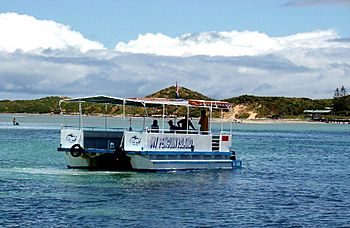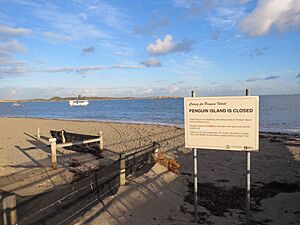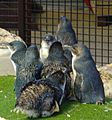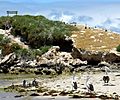Penguin Island (Western Australia) facts for kids

Penguin Island and ferry
|
|
| Geography | |
|---|---|
| Location | Indian Ocean |
| Coordinates | Lua error in Module:Coordinates at line 614: attempt to index field 'wikibase' (a nil value). |
| Administration | |
| State | Western Australia |
| LGA | City of Rockingham |
Penguin Island is a small island off the coast of Perth, Western Australia. It's about 660 meters from a place called Shoalwater. The island is famous for being home to a colony of Little penguins. In 2024, about 120 penguins lived there. Sadly, the number of penguins has dropped a lot since 2007, when there were around 1,600.
The ocean around Penguin Island is part of the Shoalwater Islands Marine Park. The island itself is also a protected area called the Penguin Island Conservation Park. This park was created in 1918 to help protect the wildlife.
The island closes to visitors every year during the winter months, from June to September. This is an important time for the penguins to breed and raise their young.
Contents
Visiting This Special Island
You can visit Penguin Island by taking a short 5-minute ferry ride from Mersey Point. You can also get there by private boat, kayak, or even swimming. Some people try to walk across a 700-meter sandbar, but this can be very dangerous. The Department of Parks and Wildlife warns against walking the sandbar because the weather can change quickly, making it unsafe.
When Can You Visit?
Penguin Island is closed during winter, from June to September. This is because it's the penguins' breeding season. There have been talks about making the closure even longer to help the penguin population recover. The island also closes if the temperature goes above 35°C. This is because the penguins can get very stressed by the heat.
In early 2025, some people who care about the environment asked for the island to be closed to visitors for several years. They hoped this would help the penguins recover. The WA Environment Minister, Reece Whitby, agreed that human activity could affect the penguins. However, he also said that climate change is the main reason for their decreasing numbers. He mentioned that tourism has been happening on the island for many years.
Island Facilities
Penguin Island has a picnic area where you can sit and find water taps. There are also special waterless toilets. You'll find many lookout spots, boardwalks, and paths across most of the island. Some areas are fenced off to protect the animals and stop the sand dunes from wearing away.
Exploring the Island Trails
The Penguin Island Walk Trail is a 1.5-kilometer path that goes around the island. It starts at the Penguin Island Discovery Center. Along the trail, you can stop at different lookout points. From these spots, you might see some of the land and sea animals.
Keeping the Island Clean
There are no rubbish bins on the island. All visitors must take their own rubbish with them when they leave. This helps keep the island clean and safe for the animals. It also stops animals like black rats from finding food. Rats have caused problems for the penguin population in the past. In 2013, a successful program helped get rid of rats on the island.
The Discovery Centre's History
A discovery center was first built on the island in 1995. In 2021, the Western Australian Government suggested building a new, bigger discovery center. This idea was first supported by the City of Rockingham. However, many local people were against it. They worried about the impact of construction on the declining penguin numbers. Because of these concerns, the City of Rockingham stopped supporting the plan.
In August 2022, the WA Government announced that they would not build a new center. They also decided to pull down the old discovery center and restore the area. The existing center closed in 2023.
Amazing Nature and Wildlife
While the Little penguins are the most famous animals on the island, you can see many other birds. These include a large group of about 500 pelicans that nest and rest there.
Unique Island Shapes
Penguin Island has many interesting natural shapes. You can see cliffs, small sea caves, rocky points, beaches, and coves. There are also natural bridges and flat rock areas shaped by the waves. Some important spots on the island include North Rock, Pelican Bluff, and South Beach.
Protecting Our Penguins
In the past, during the 1800s and 1900s, penguins on the island faced dangers. Dogs and people with guns sometimes harmed them. In the 1940s, people worried about the penguins because of human visitors, occasional fires, and many rabbits. The rabbits ate too much of the island's plants, causing erosion. Rabbits were thought to have arrived in the 1920s. By 1950, it became against the law to bring a dog to Penguin Island.
Australian sea lions were also known to visit the island around the early 1900s.
Challenges for Penguins
Today, it's rare to see wild Little penguins on the island during the day. For most of the year, they spend daylight hours at sea, hunting for fish. Visitors are only allowed on the island during specific daylight hours from mid-September to early June.
The Little penguin population on Penguin Island is special and is decreasing. In 2007, there were between 1,600 and 2,000 penguins during breeding months. By 2011, this number dropped to about 1,000, and by 2022, it was around 250. Scientists have seen penguins traveling further to find food. This means their chicks don't get enough to eat and can starve. Less food and climate change are big problems for the breeding penguins. A plan to build a marina nearby is also seen as a future threat.
Little penguins also breed on Garden Island, which is about 6.5 kilometers north. These two groups of penguins are considered one large population. In 2007, this combined population had about 2,369 penguins.
Rescued Penguins' New Homes
For many years, a small group of rescued penguins lived in a special area on the island. This was part of the Discovery Centre. It was built in 1987 to care for injured wild penguins. It also housed about 10 penguins that were too hurt, orphaned, or born in captivity to survive in the wild. This enclosure was designed to look like the penguins' natural home, with sand, coastal plants, and a saltwater pond. Visitors could watch the penguins swim through viewing panels. Park rangers fed the penguins three times a day.
In September 2023, the last seven penguins from the center moved to new homes. They now live with other penguins at Perth Zoo and Caversham Wildlife Park. This happened after the decision to close the Discovery Centre permanently.
Images for kids
See also








